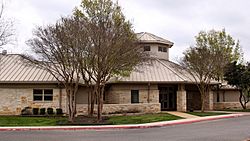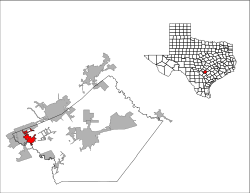Cibolo, Texas facts for kids
Quick facts for kids
Cibolo, Texas
|
|
|---|---|

Cibolo City Hall
|
|

Location of Cibolo in Guadalupe County, Texas
|
|
| Country | United States |
| State | Texas |
| Counties | Guadalupe, Bexar |
| Government | |
| • Type | Council-Manager |
| Area | |
| • Total | 20.94 sq mi (54.23 km2) |
| • Land | 20.91 sq mi (54.16 km2) |
| • Water | 0.03 sq mi (0.07 km2) |
| Elevation | 692 ft (211 m) |
| Population
(2020)
|
|
| • Total | 32,276 |
| • Density | 1,495.91/sq mi (577.58/km2) |
| Time zone | UTC-6 (Central (CST)) |
| • Summer (DST) | UTC-5 (CDT) |
| ZIP codes |
78108
|
| Area code(s) | 210, 726 |
| FIPS code | 48-14920 |
| GNIS feature ID | 2409462 |
Cibolo is a city in Guadalupe and Bexar counties in Texas, United States. It's part of the larger San Antonio–New Braunfels area. Cibolo became its own town on October 9, 1965. In 2020, about 32,276 people lived there, which is a big jump from 15,349 people in 2010!
Contents
History
Cibolo officially became an independent town on October 9, 1965. The first leaders, sometimes called the "City Fathers," included Mayor M.O. Grooms and council members Carl Biser, Ted Dykes, Alwin Lieck, Fred Niemietz, and D.O. Trotti.
Long before European settlers arrived, Native American tribes like the Comanche lived in this area. The name Cibolo actually means "buffalo" in Spanish. The community started growing when the Southern Pacific Railroad built tracks through the area, connecting big cities like Houston and San Antonio. Over time, Cibolo grew into the busy suburb it is today.
In 1867, a man named George Schlather built a store. Later, in 1882, Charles Fromme bought it and renamed it Fromme's Store. For a while, the community was even known by that name! In 1877, the train station here was called Cibolo Valley. Then, in 1883, the U.S. Post Office opened a branch and officially named the town Cibolo. By 1890, about 100 people lived here.
Since the year 2000, Cibolo has grown incredibly fast. Its population increased by 733% from 3,035 people in 2000 to 32,276 in 2020. This rapid growth means that Cibolo now makes up a much larger part of Guadalupe County's population than it used to.
Geography
Cibolo is located in western Guadalupe County, right next to Cibolo Creek. A small part of the city even crosses into Bexar County. Nearby towns include Santa Clara and Marion to the east, and Schertz to the north and west. The city of New Braunfels is about 14 miles northeast, and downtown San Antonio is about 21 miles southwest.
The U.S. Census Bureau says Cibolo covers a total area of about 17 square miles (44 square kilometers). Only a tiny bit of this area, about 0.07%, is covered by water.
Transportation
Airports
- Austin-Bergstrom International Airport is about an hour's drive away.
- San Antonio International Airport is closer, about 30 minutes away.
Major Roads
 Interstate 35: This major highway connects Cibolo to cities like Austin, San Antonio, and Laredo.
Interstate 35: This major highway connects Cibolo to cities like Austin, San Antonio, and Laredo. Interstate 10: Another big highway, it links Cibolo to Houston, El Paso, and even Los Angeles.
Interstate 10: Another big highway, it links Cibolo to Houston, El Paso, and even Los Angeles. FM 78: This road goes through Kirby, Randolph Air Force Base, Cibolo, and other towns.
FM 78: This road goes through Kirby, Randolph Air Force Base, Cibolo, and other towns. FM 1103: This road runs through Cibolo.
FM 1103: This road runs through Cibolo.
Cibolo Parkway (Proposed)
A new road called the Cibolo Parkway has been planned to extend FM 1103. This new parkway would create a direct route between Interstate 35 and Interstate 10, which would help with traffic and make travel easier.
The idea for this road started in 2006. In 2007, the Texas Department of Transportation (TxDOT) looked into it but found it would be difficult to build because of floodplains and crossing other roads and train tracks.
However, as Cibolo grew, the city council decided to look into building the parkway again in 2015. They even thought about working with a private company to build it as a toll road. In 2017, the city approved an agreement for this project. But in 2020, the city council decided to end that agreement. The future of the Cibolo Parkway is still being discussed.
Demographics
| Historical population | |||
|---|---|---|---|
| Census | Pop. | %± | |
| 1970 | 440 | — | |
| 1980 | 549 | 24.8% | |
| 1990 | 1,757 | 220.0% | |
| 2000 | 3,035 | 72.7% | |
| 2010 | 15,349 | 405.7% | |
| 2020 | 32,276 | 110.3% | |
| 2021 (est.) | 33,475 | 118.1% | |
| U.S. Decennial Census | |||
Cibolo is a very diverse city! As of 2020, there were 32,276 people living here. The population includes people from many different backgrounds, with significant numbers of White, Black or African American, Asian, and Hispanic or Latino residents.
In 2000, the city had 3,035 people. About 43% of households had children under 18 living with them. The average household had almost 3 people. The median age was 35 years old.
Cibolo has grown incredibly fast, becoming one of the fastest-growing small cities in the United States. This rapid growth has brought some challenges, as the city works to keep up with the needs of its quickly increasing population.
Schools
The Schertz-Cibolo-Universal City Independent School District (SCUCISD) serves students and families in Cibolo.
High Schools
These schools are for grades 9-12.
- Allison Steele Enhanced Learning Center (Schertz)
- Byron P. Steele II High School (Cibolo)
- Samuel Clemens High School (Schertz)
Junior High Schools
These schools are for grades 7-8.
- J. Frank Dobie Junior High (Cibolo)
- Ray D. Corbett Junior High (Schertz)
Intermediate Schools
These schools are for grades 5-6.
- Barbara Jordan Intermediate (Cibolo)
- Laura Ingalls Wilder Intermediate (Schertz)
- Elaine S. Schlather Intermediate (Cibolo)
Elementary Schools
These schools are for kindergarten through grade 4, and sometimes preschool.
- Cibolo Valley Elementary (Cibolo)
- Green Valley Elementary (Schertz)
- Maxine & Lutrell Watts Elementary (Cibolo)
- Norma J. Paschal Elementary (Schertz)
- O.G. Wiederstein Elementary (Cibolo)
- Rose Garden Elementary (Schertz)
- Schertz Elementary (Schertz)
- John A. Sippel Elementary (Schertz)
Notable people
- Tommy Armstrong Jr., a professional football player.
- Malcolm Brown, a professional football player.
- Terence Steele, a professional football player for the Dallas Cowboys.
- Caden Sterns, a professional football player for the Denver Broncos.
Images for kids
See also
 In Spanish: Cibolo (Texas) para niños
In Spanish: Cibolo (Texas) para niños


